Cave Architecture in India
The importance of caves in human life is inextricably related to their cultural evolution. The pre-historic humans initially used the caves as dwelling units. Gradually, the caves became a focal point for their cultural activities. The cave walls became projections of human imaginations in the form of murals, such as hunting scenes, merry-making, etc.
With the emergence of human settlements and the advancement of human civilizations, caves assumed a more sophisticated role. They come to serve as prayer halls and residing places for monks. Artificial caves began to be carved and profusely decorated with sculptural panels, paintings, and other features.
In this chapter, we shall study the architecture of the rock cut caves.
Classification
Cave tradition in India can be divided into the following categories: 
- Mauryan caves
- Post-Mauryan caves, which can be further classified as Western caves and Eastern caves
- Other cave traditions
Mauryan caves
Rock-cut caves dating back to the 3rd century BCE have been found in different parts of the country. Initially, patrons were individuals or collectives of guilds or artisans. Later, as states rose to prominence, kings became the chief patrons of the caves. They commissioned the carving of magnificent caves to project their power. 
Some of the most well-known rock-cut caves are in the Barabar hills and Nargarjuni hills of Jehanabad district near Gaya in Bihar. Most (not all) of these caves were explicitly dedicated by the Mauryan rulers (Ashoka – 304-232 BCE, and Dashratha – 232–224 BCE) to the Ajivika sect as revealed through inscriptions.
The Ashoka inscriptions in the Barabar Caves are part of Ashoka’s “Minor Rock Edicts” and appear in three caves: Sudama, Visvakarma and Karna Chupar. They identify “King Piyadasi” as Ashoka. The inscriptions in the Nagarjuni caves cite “Devanampiya Dasaratha” for King Dasratha, Ashoka’s grandson.
| Hill | Caves | Key Points |
| Barabar Hill |
|
|
| 2. Sudama Cave |
|
|
| 3. Karan Chaupar Cave |
|
|
| 4. Viswa karma Cave |
|
|
| Nagarjuni Hill | 1. Gopika or or Gopi-ka-Kubha Cave |
|
| 2. Vadathika Cave |
|
|
| 3. Vapiyaka Cave |
|
Ajivikas |
|
LOMAS RISHI CAVE 
Facade of the cave: A semi-circular chaitya arch is found at the entrance giving it a hut-style façade. It is a stone reproduction of contemporary wooden architecture.
The arch is sculpted in high relief with a row of elephants moving towards the stupa emblem, indicating that the cave was probably dedicated to the Buddhists.
The interior is a rectangular hall with a circular chamber at the back. The entrance is located on the side of the hall.
Significance
- The Buddhist innovation in the gate architecture of the Lomas Rishi cave was emulated in the later Buddhist architecture in various parts of the subcontinent.
- Ex: The Kondivite and Guntupalli caves are the direct successors to the Lomas Rishi cave.
Post-Mauryan Caves
Notation: MH= Maharashtra. AP = Andhra Pradesh, MP = Madhya Pradesh, KA = Karnataka.
Western caves
| Site | Location | Timeline | Religion/sect |
| Pitalkhora | Aurangabad district, MH | 3rd c. BCE – 4th c CE | Buddhist |
| Bhaja | Pune district, MH | 2nd c. BCE | Buddhist |
| Karla | Lonavala, Pune, MH | 2nd c. BCE ‒ 5th c. CE | Buddhist |
| Ajanta | Aurangabad district, MH | 2nd c. BCE ‒ 6th c. CE | Buddhist |
| Kondana | Lonavala, Pune, MH | 1st c. BCE | Buddhist |
| Bedsa | Pune district, MH | 1st c. BCE | Buddhist |
| Thana-Nadsur | Near Mumbai, MH | 1st c. BCE | Buddhist |
| Nashik | Nasik district, MH | 1st c. BCE ‒ 3rd c. CE | Buddhist |
| Kondivite or Mahakali | Andheri, near Mumbai | 1st c. BCE ‒ 6th c. CE | Buddhist |
| Junnar | Pune district, MH | 1st ‒ 3rd c. CE | Buddhist + Hindu |
| Kanheri | Near Mumbai, MH | 1st ‒ 10th c. CE | Buddhist |
| Elephanta | Elephanta Island, near Mumbai. | Mid-5th to 6th centuries CE | Buddhist, Hindu |
| Ellora | Sambhajinagar district, MH | 5th ‒ 11th c. CE | Buddhist, Jain, Hindu |
Eastern caves
| Site | Location | Timeline | Religion/sect |
| Guntapalle | Eluru district of AP | 2nd c BCE | Buddhist |
| Anakapalli | Near Visakhapatnam, AP | 4-5th c. CE | |
| Udaigiri-Khandagiri | Odisha | 1st c. BCE | Jain |
Other cave traditions
| Site | Location | Timeline | Religion/sect |
| Bagh caves | Indore in MP | 2nd c. BCE | Buddhist |
| Badami cave | Bagalkot district, KA | 6th c. CE | Hindu, Jain |
| Aihole caves | Near Visakhapatnam, AP | 6th – 12th c. CE | Hindu, Jain |
| Undavalli | Vijayawada, AP | 4th – 5th c. CE | Jain, Buddhist |
| Mamallapuram | Mahabalipuram | Vaishnavism, Shaivism |
Buddhist Cave Architectural Types
The Buddhist cave architectural style that originated in the Rajmahal hills developed further and spread throughout India with several unique and sophisticated variations. We shall study these in depth in this section.
Chaitya Halls 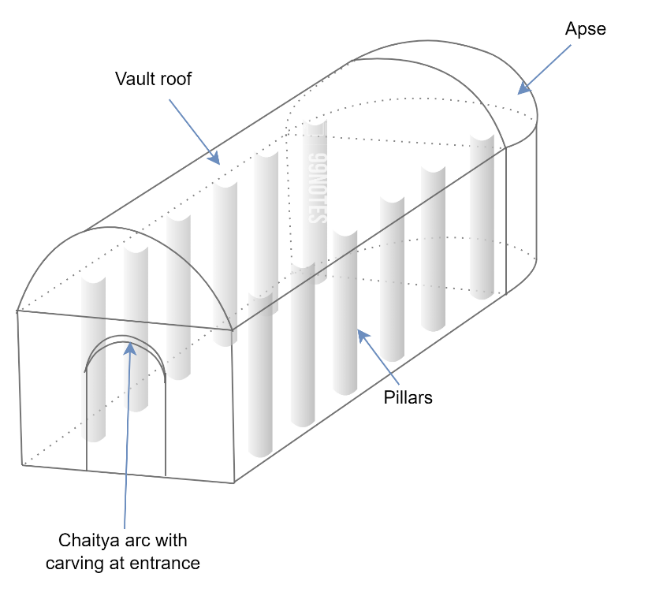
Western cave traditions dating back to the 2nd century BCE fall in mainly 3 architectural types:
- Apsidal vault roof chaitya halls – Found at Ajanta, Pitalkhora, Bhaja
- Apsidal vault-roof pillarless hall – Found at Thana-Nadsur
- Flat-roofed quadrangular hall with a circular chamber at the back – Found at Kondivite.


Apsidal vault roof chaitya halls: 
The standard plan of this variety of chaitya halls contains:
- A decorated semi-circular chaitya arch as its façade, the exception being Kondivite.
- In all chaitya’s caves, a stupa at the back is common.
Changes in the standard plan from the 1st century BCE include: 
- The halls become rectangular, as in Cave No. 9 of Ajanta Caves.
- A stone-screen wall replaces the chaitya-arch as the façade.
- This plan has also been found at Bedsa, Nashik, Karla and Kanheri.
- One of the Kanheri caves bears an elaboration of the chaitya hall plan at Karla.
- Flat-roofed quadrangular hall with a circular chamber at the back ‒ This plan appeared in subsequent periods.
Viharas
The viharas are excavated in all the cave sites. The plan of the viharas consists of the following:

- A verandah.
- A hall.
- Cells around the walls of the hall.
Examples of vihara caves:
- Ajanta Cave No. 12
- Bedsa Cave No. 11
- Nashik Cave Nos. 3, 10 and 17
Features and evolution of viharas:
Early vihara caves were generally carved with interior decorative motifs like chaitya arches. In addition, there were Vedica designs on the cell doors.
Chaitya-vihara:
At later stages, stupas were added at the back of the vihara hall. Therefore, the viharas became chaitya-vihara.
During the 4th and 5th centuries CE, images of the Buddha began to be carved in the stupas. However, many caves have been converted into modern Hindu shrines, due to which the Buddha images could not be found.
For example, in the vihara cave in Junnar, an idol of Ganesha was installed in the later times. It is therefore also known as the Ganeshleni Cave. (Remember Pandav Leni cave is in Nashik)
AJANTA CAVES
- Location: Aurangabad district of Maharashtra.
- Geography: These caves are strategically cut into a 250-ft mountain wall above the Waghora River, probably on the border of the ancient province called Risika.
- Designated as a UNESCO World Heritage Site.
- Discovered by John Smith, a British cavalry officer, in 1819. The name Ajanta comes from a nearby village called Ajintha, which served as a Buddhist pilgrimage site and a centre of Buddhist learning.
Patrons
| Cave # | Patron |
| 16 | Varahadeva, the prime minister of Vakataka king, Harishena (480 – 510 CE). |
| 17, 18, 19, 20 | Upendragupta, a feudatory of Vakataka, King Harishena |
| 1 | Funded by King Harishena |
| 26 | Buddhabhadra (a monk) |
| 4 | Mathuradasa |
Note: It is not important to learn about the individual Caves. This detail is provided only as additional information about the Ajanta Caves.
Timeline 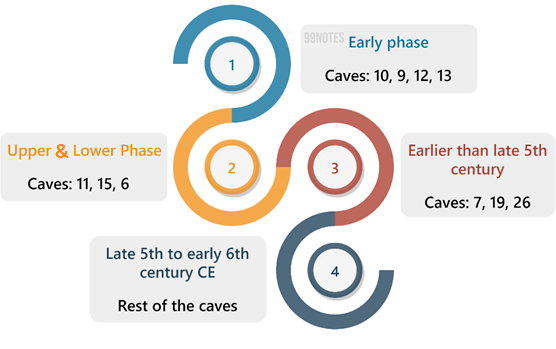
Caves are dated from the 2nd century BCE to the 5th century CE. Although, there are no dated inscriptions, leading to difficulty in establishing their chronology. However, two clear phases, both under Hindu rulers, can be identified:
| Phase 1 | Phase 2 | |
| Timeline | 2nd and 1st century BCE | 3rd century CE to 5th century CE |
| Buddhism tradition | Early Hinayana tradition | Mahayana tradition |
| Patron | Satavahanas | Vakatakas – mainly under king Harishena (480 – 510 CE). |
| Paintings | Caves were fully painted but fell into disuse; only a small part of the original paintings survived. | Paintings are in narrative form – showing numerous individual scenes interwoven to form a visual storyline. |
| Duration | It seems that the caves were completed very quickly yet meticulously in a short span of 18 years. |
Out of 29 caves that have been found at this site, only 4 caves are chaitya-caves and 26 caves are vihara.
Chaitya caves – Cave 19 and Cave 26
These are Apsidal-vault-roof varieties.
- The Roof and the pillars are elaborately carved.
- The Façade is decorated with Buddha and Boddhisattva images.
Vihara caves at Ajanta

(Source: Wikipedia)
- The Vihara caves follow the standard plan. The back walls contain the main Buddha shrines, which are grand in size.
- Some vihara caves are unfinished – 5, 14, 23, 24, 28, 29.
Paintings of Ajanta Caves
Paintings have survived in Caves 9 and 10 of the earliest phases (1st century BCE); and in Caves 1, 2, 16 and 17 of the later stage (5th century CE). Other caves, too, had paintings but could not survive.
| Phases | Caves |
| Phase 1 | Caves 9 and 10 – paintings from the 1st century BCE. |
| Phase 1 – Later paintings | Caves 9 and 10 – images of the Buddhas painted on the walls and pillars. |
| Phase 2 | Caves 1, 2, 16 and 17 ‒ 5th century CE. |
Phase 1 painting (Cave 9 and 10 – 1st century BCE):
In the early phase (1st century BC), paintings are an afterthought as is evident from the plastering over the early inscriptions inside the cave. For Example, Paintings are an afterthought in Cave 10. However, in the case of Cave 9, it is pre-planned.
- Figures are broad with heavy proportions, arranged linearly in the picture space.
- These paintings have sharp lines and limited colours are used.
- Grouping of events based on geographical location with outward architectural bands separating two groups. These are tiered and horizontally arranged.
- Figures resemble the Sanchi sculptures, showing the parallel development of the lithic and painting traditions. Ex: the frontal knot of the headgear
Phase 2 painting (Caves 1, 2, 16 and 17 ‒ 5th century CE):
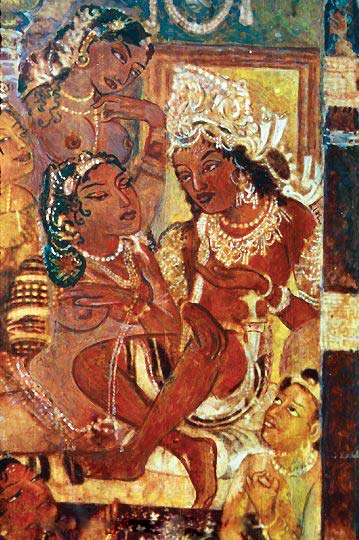
By the 5th Century CE, lines became clearly defined and very rhythmic. The body colour gets merged with the outer line creating the effect of volume. These are the earliest examples of Fresco in India, i.e. Technique of Mural painting on freshly laid lime plaster. We have covered this technique in the chapter related to Paintings in India.
- Use of outward projections (5th century CE onwards), giving an effect of volume.
- There is Heaviness in the paintings like the sculptures. For example, the contours are done in dark brown thick lines.
- There is considerable naturalism and there is no over-stylisation or exaggerated facial features.
- The typological and stylistic variations indicate the paintings were the work of different guilds of artisans.
- Multicoloured populations have been represented through various skin colours in the paintings, such as brown, yellowish brown, greenish, yellow ochre, etc.
- Major Examples:
- Paintings of Cave 16, 17: Paintings are precise and elegant. The bulkiness of the sculptures is no longer reflected in the paintings. Movements in the figures are very rhythmic. Lines are forceful and full of energy.
- Paintings of Cave 1 and 2: The Figures are arranged in a circular arrangement of figures giving a three-dimensional effect. The Eyes are half-closed and elongated.
- Some figures in Cave 2 are affiliated with the Vengi sculptures and Vidarbha sculptural traditions.
Themes of the paintings:

✓ Events from the life of the Buddha ✓ The Jatakas ✓ The Avadanas.
- Paintings of Simhala Avadana, Mahajanaka Jataka and Vidhurpundita Jataka cover the entire walls of the cave.
- Chaddanta Jataka – is painted in Cave 10 (early phase) and Cave 17 (later phase).
- Painting in Cave 10 — The grouping of events and details is based on their geographical location (place of occurrence). ⋄ faithfully follows the Pali text.
- Painting in Cave 17 — Deviations from the Pali text seen – Ex: Chaddanta is shown removing his tusk and giving it to the hunter, Sonuttar.
| Ajanta Cave # | Important paintings found |
| 17 |
|
| 1 |
|
| 10 |
|
Other Caves during the Ajanta Period
The caves built during the Ajanta period in the Deccan region of India have the same characteristics as the Ajanta Caves.
Pitalkhora Caves

- Pitalkhora caves are older than the Ajanta caves. The inscriptions here date back to c. 250 BCE. These are a group of 14 caves in the Satmala Range of Maharashtra.
- It features statues of elephants, gatekeepers, Gaja Lakshmi and an ancient rainwater harvesting system.
- It contains paintings of the Mahayana period.
- The Cave is also famous for having an ancient rainwater harvesting system.

Bagh Caves
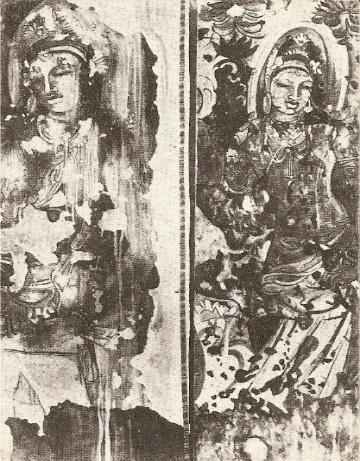
- Located in Indore in Madhya Pradesh, it was established by the Buddhist monk Dataka in the late 4th – 6th century CE.
- It is known for Mural Paintings – use the tempera
- Painting Theme: Secular and religious (Buddhism is the main inspiration). The painting style is influenced by Ajanta.
JUNNAR CAVES
Near Junnar is a complex of around 200 rock-cut caves in the western Ghats. These include Manmodi Caves in the South of Junnar, Tulja Caves, Shivneri Caves and Lenyadri Caves. 
- Patron: Satavahanas and Western Satraps.
- Excavated in: Tulji hill, Shivneri hill, Lenydri range, Manmodi hill, Nanighat pass; Near Pune.
- Various architectural styles have been found – Most caves have apsidal vaulted chaityas, while others have flat-roofed rectangular ones.
- A unique circular chaitya type has also been found as shown in the figure here.
Nashik Caves
Nashik caves are the best places to study the structure of Vihara-type caves. 
Façade design in Nashik caves (3, 10, 17) is a distinct achievement. The viharas have front pillars carved with ghata-base and ghata-capital with human figures.
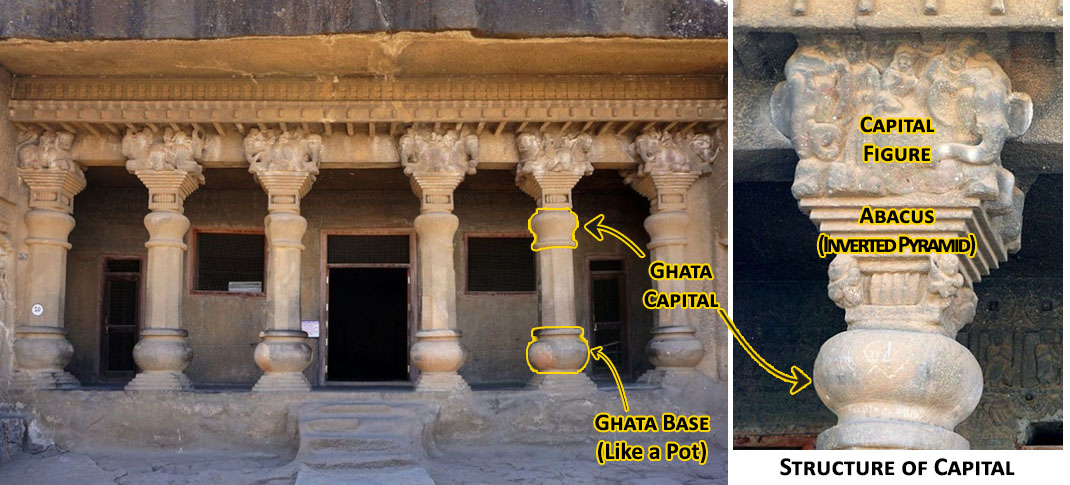
Karla Caves

- Karla Caves near Pune belong to the 2nd Century BCE to the 5th Century CE. It was located at the ancient trade route between Deccan and the Arabian Sea.
- In the Karla caves, the biggest rock-cut chaitya hall was excavated. The Chaitya hall is decorated with human and animal figures, showing movement in space.
- The façade is a stone screen wall. Chaitya is of apsidal vault-roof type with pillared halls and a stupa at the back.
UDAIGIRI-KHANDAGIRI CAVES
- Also called Kattaka Caves or Cuttack Caves. It is mentioned as Kumari Parvata in the Hathigumpha inscription. These Caves are scattered over several places.
- Bears inscriptions of Kharavela kings state that the caves were meant for Jaina monks. These were carved in the 1st century BCE.
- Notable caves at Udayagiri: Rani Gumpha, “Cave of the Queen” (Cave 1), Ganesha Gumpha (Cave 10), Hati Gumpha (Cave 14).
- Notable caves at Khandagiri: Ambika Gumpha (Cave 10).
- Numerous single-cell excavations were found. Some have been carved in huge independent boulders and given the outer shape of animals.
- A big cave has a pillared veranda with cells at the back.

Details Of The Veranda, Udaigiri-Khandagiri

- Figures – voluminous, move freely in the picture space, qualitative carving, cells decorated with chaitya arches.
ELLORA CAVES

- Located in Aurangabad District, 100 kilometres from Ajanta caves, in Charanandri hills, Waghora river.
- Designated as a UNESCO World Heritage Site.
- Timeline: 5th to 12th century CE.
- It is a unique art-historical site in the country for the following reasons:
Patrons:
- Kalachuris, in early phases, from the mid-6th to late 8th
- Rashtrakutas, in later phases, from the 8th to 10th
Buddhist Caves (Caves 1-12)
- They contain images from Vajrayana Buddhism ‒ Tara, Mahamayuri, Akshobhya, Avalokiteshwara, Maitrya, Amitabha.
- Other images: Manushi Buddhas, Vairochana, Ratnasambhava, Amoghsiddhi, Vajrasatva, Vajraraja.
- Caves are big, with massive pillars.
- Caves were painted, but the paintings have not survived.
- The images of Buddha are big and guarded by Padmapani and Vajrapani.
- Cave 10 is called Visvakarma or Sutar-ki-jhopari, the Carpenter’s cave. It bears a seated Buddha sculpture.
- Caves 11 and 12 are triple-storeyed (Teen tal).

Cave 11 At Ellora. (Source: Wikipedia)
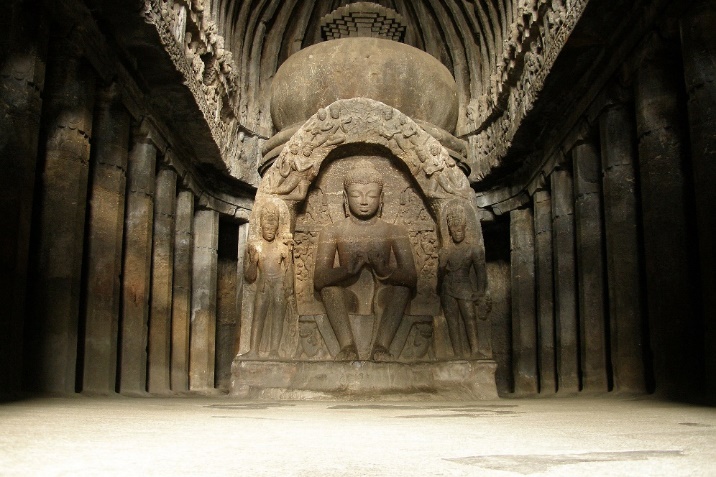
Brahmanical Caves at Ellora (Caves 13-29)
- Images of Shiva and Vishnu and their various forms per the Puranic narrative have been depicted. However, Shaiva caves are more common.
- River goddesses Ganga and Yamuna sculptures at the entrance are common.
- Cave 14 is the only double-storey cave of the Brahmanical faith.
- These caves are on the sloping side of the cliff; Therefore, temples have a courtyard.
| Cave # – Name | Details |
| 21 – Rameshwar Lena |
|
| 14 ‒ Ravan ki Khai |
|
| 15 ‒ Dashavatara temple |
|
| 16 ‒ Kailash Leni or the Kailashnath Cave
(Discussed in Vesara Architecture) |
|
Jain Caves at Ellora (Caves 30-34)
| Figure: Gomateshwara in Cave 32 at Ellora (Source: Wikipedia) |
| Figure: Lord Mahavira in Cave 32 at Ellora (Source: Wikipedia) |
There is a total of 5 Jaina caves in the Ellora.
| Cave # – Name | Details |
| 30 ‒ Chhota Kailash |
|
| 31 |
|
| 32 ‒ Indra Sabha Cave |
|
| 33 ‒ Jagganath Sabha |
|
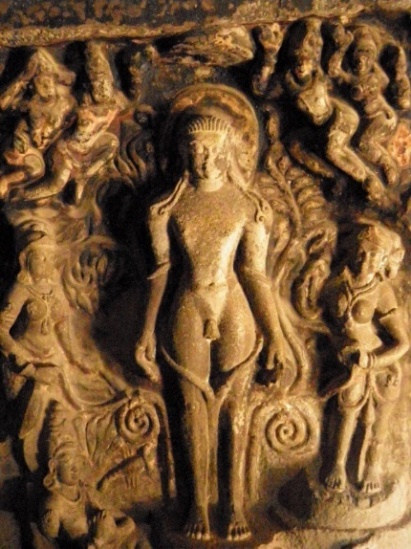

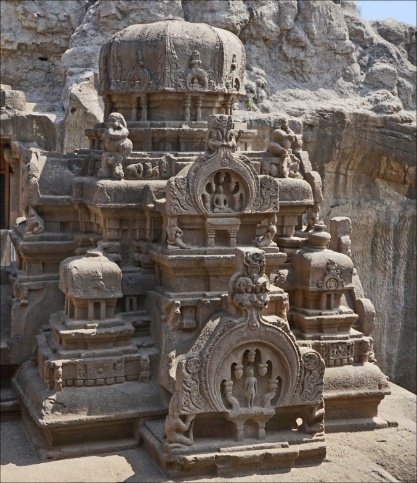
Other features
- Pillar designs evolve from Buddhist caves to Jain caves in the 9th century CE, becoming very ornate, and the decorative forms gain heavy protrusion.
- The placement of lotus carving on the cave ceiling is seen in two Jaina caves and a Hindu cave, representing the caves as sacred places.
Other Caves of Ellora Period:
Elephanta caves and Kanheri caves belong to this age. The caves started to take the shape of temples in this era, as was the case with the Kailashleni cave (Ellora).
We see such practice in other parts of India too. For example, Ravanphadi Cave (Aihole), Badami Caves and Varaha Cave Temple (Mahabalipuram) etc.
ELEPHANTA CAVES 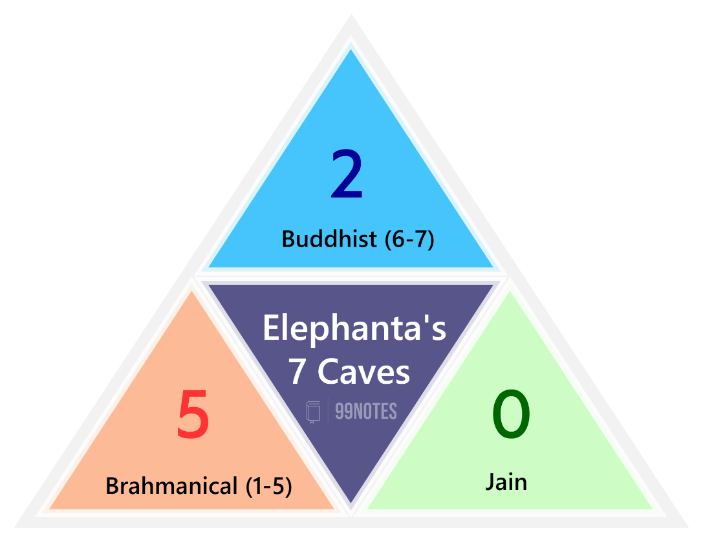
It is located on Elephanta Island, near Mumbai. It is locally called Gharapuri Island. It has been designated as a UNESCO World Heritage Site.
- Timeline: Hinayana Buddhists first occupied this island around the 2nd century BCE, later it was dominated by the Shaivite faith till the 7th century CE, for which it is now known.
- Patrons of the Elephanta caves are debated. They were probably excavated during the reign of the Chalukyas, the Rashtrakutas or the Kalachuris.
- Caves 2-5 are unfinished or badly damaged, with few artistic remains.
| Cave # – Name | Details |
| 1 ‒ Central Shrine or Great Cave Shrine | It is around 39 metres in length, with sculptures as high as 7m high. Even the smallest sculptural panels are 3m – 4m high.
Sculptures –
|
| 6 ‒ Sitabai’s Temple Cave | It was a stupa cave used by the monks. It was converted and used as a Christian church by the Portuguese during their rule. |
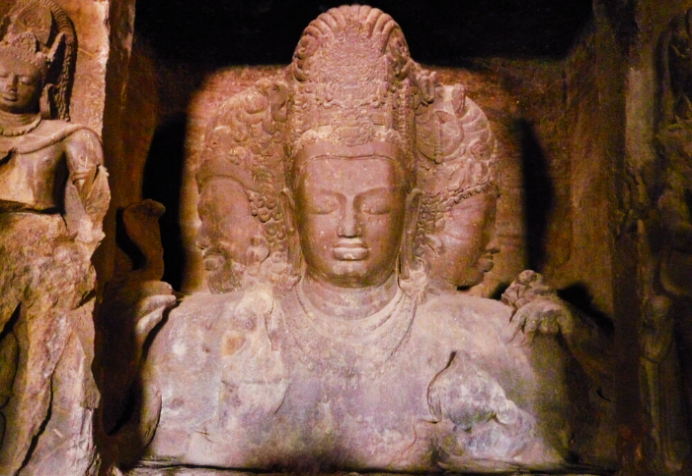
KANHERI CAVES
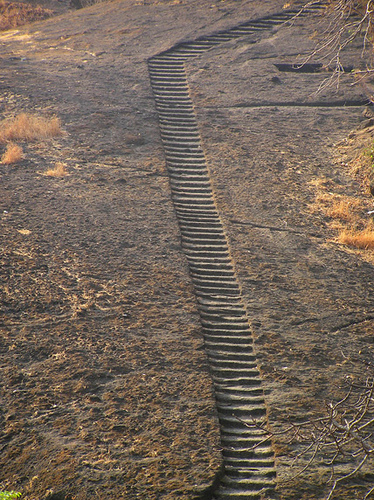
- 109 caves have been found in the complex.
- It has more elaborate decorations than Karla Chaityas. But the cave interior is not fully finished. Its chaitya hall plan is of quadrangular flat-roofed variety.
- One of the significant inscriptions mentions the marriage of Satavahana ruler Vashishtiputra Satakarni with the daughter of Rudradaman I.
CAVES OF ANDHRA PRADESH
GUNTAPALLE CAVES
- Dated: 2nd century BCE.

Entrance At Guntapalle Caves - Small apsidal and circular chaitya halls have been found.
- Unique thing: structured stupas, viharas and caves are excavated in one place.
- It has a circular chaitya cave, a stupa in the circular hall, and a chaitya arch carved at the entrance.
- Vihara caves are smaller, decorated with chaitya arches on the exterior, rectangular apsidal vault type, 1 or 2- 2-storeyed, without a large central hall.
ANKAPALLE CAVES
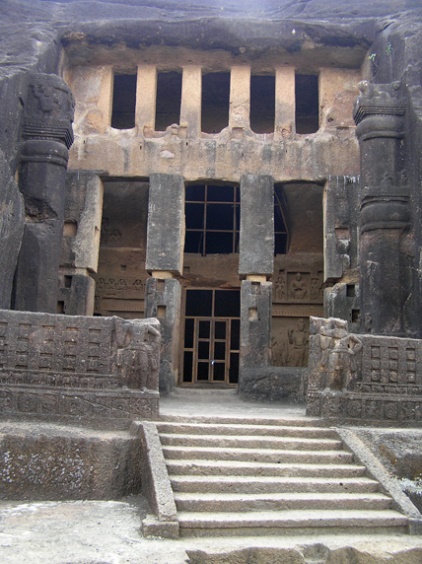
- Dated: 4-5th century CE.
- A huge rock-cut stupa is carved out of the hillock, forming the country’s biggest rock-cut stupas.
- Unique thing: it has the biggest rock-cut stupas in the country.
In Rampaerrampallam, very moderate small excavations of Rock-cut stupas exist on the hillock.
Related FAQs of Cave Architecture in India
Caves initially served as shelters for prehistoric humans. Over time, they evolved into cultural hubs, becoming prayer halls, residences for monks, and eventually sophisticated rock-cut temples adorned with carvings and paintings.
Ajanta Caves are a UNESCO World Heritage Site known for their beautiful paintings and architecture. They showcase the evolution of Buddhist art from Hinayana to Mahayana traditions, with intricate murals, chaityas (prayer halls), and viharas (monasteries).
Mauryan caves, like those at Barabar Hills, were simple and functional with polished interiors, often dedicated to the Ajivikas. Post-Mauryan caves, such as Ajanta and Ellora, were more elaborate, with religious iconography, murals, and architectural advancements.
A Chaitya is a prayer hall with a stupa at one end, often featuring an apsidal (semi-circular) end. A Vihara is a monastery consisting of a hall surrounded by small living cells for monks. Some viharas later included Buddha images and became Chaitya-viharas.
Jain cave architecture is prominently seen at Ellora (Caves 30–34), especially the Indra Sabha cave. These caves include detailed carvings of Jain Tirthankaras, monolithic shrines, and elaborate pillars reflecting Jain religious symbolism.







